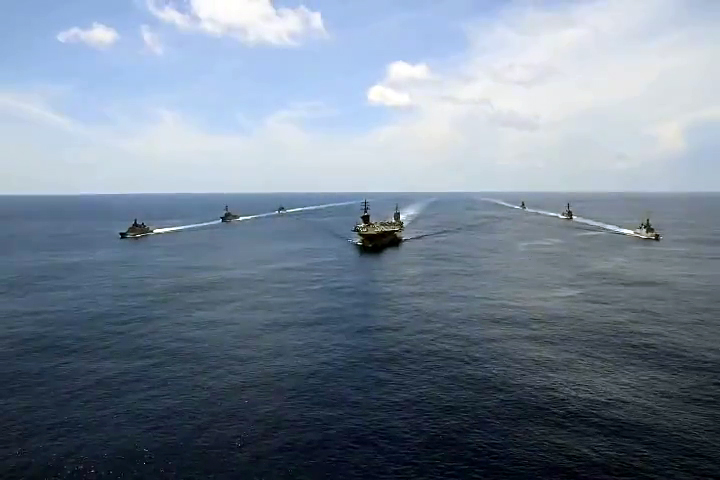With the upcoming India-USA 2+2 talks and the expected signing of the MISTA and BECA protocols, India will be poised to join the existing ‘fleet intelligence federation’.
Switzerland: On 26 and 27 October, India and the United States will conduct the third round of the 2+2 Dialogue where each nation’s Defence and Foreign Ministers will discuss a range of issues of importance to each nation. This meeting is set against the backdrop of an expanding, and increasingly aggressive and violent, People’s Republic of China (PRC), especially as it relates to ensuring freedom of navigation and free access to markets across the high seas.
Especially recently, India and the US haven’t just been talking to each other, they’ve also been acting together. For example, in early October a US Navy P-8 reconnaissance aircraft was seen landing at the airport in Port Blair on the Andaman Islands. This event was not only a signal to Beijing that their submarines would not be invisible to US naval intelligence, but it was a signal of a burgeoning effort to share tactical intelligence between the US and Indian navies.
That combined effort will take a great leap forward if, as expected, this meeting of the India-USA 2+2 sees the signing of two agreements, the Maritime Information Sharing Technical Agreement (MISTA) and the Basic Exchange and Cooperation Agreement (BECA).
Given the PRC’s past two-decades’ effort to build the world’s largest, and potentially the most lethal Navy in the world, the issue of how the United States and India share maritime intelligence may be one of the most important steps to operationalising the Quad alliance and turn it into a credible deterrent against Beijing’s militant expansionism.
Why do I say this? As the former Director of Intelligence and Information Operations for the US Pacific Fleet I know first-hand the value of being able to track adversary ships and submarines at sea, what we in the US Navy call maritime operational intelligence (OPINTEL).
Maritime OPINTEL was birthed in our Navy after the devastating attack on Pearl Harbor on 7 December 1941 and underpinned the dramatic victory at Midway, just six months later. As then Pacific Fleet Commander, Admiral Chester Nimitz stated, the success at Midway was “in large measure, due to the excellent intelligence received” from the combined intelligence and cryptologic teams of the first truly “federated” process for collecting, analysing and disseminating tactically relevant maritime OPINTEL to the Fleet.
It was from these origins that the US Navy developed the Ocean Surveillance Information System (OSIS) during the Cold War that shared world-wide tracking of the Soviet Navy from a network of centres and facilities.
Following the end of the Cold War the US Navy’s OSIS network devolved as the Russian Navy essentially retreated from the world’s oceans and as US national interests shifted to the ground operations of the Middle East.
However, beginning in 2003 it became clear to some of us in the US Navy that the PRC’s strategic trajectory was intent on building a global naval force, one that the US Navy and our allies would need to be able to find, fix, and track.
Despite severe funding shortfalls under the Obama era of sequestration, in 2012 the US Navy ushered in a new era of maritime OPINTEL with the formal establishment of the Pacific Fleet Intelligence Federation (PFIF). The PFIF provided direction for the organisation and collaboration of the Pacific Fleet’s intelligence and cryptlologic resources to support the maritime OPINTEL mission of the Pacific Fleet across the Indo-Pacific waters.
What is unique about this “federated” system is the collaboration and coordination across multiple organisations at various echelons, afloat and ashore, working in unison 24 hours a day, seven days a week, providing the most precise maritime OPINTEL to afloat forces. By “federating” the efforts across nodes in Japan, Hawaii, San Diego, and Washington D.C., each node brings its unique capability to build the adversary Common Operational Picture (RED COP), thus increasing our learning and understanding about the pattern of life of the adversary navy.
By dividing tasks functionally and geographically, the “federated” approach increases focus and deepens analysis of maritime threats. The endstate is to more effectively (and efficiently) deliver intelligence to commanders and decision makers at every echelon.
In the years since its creation, and as originally conceptualised, this “fleet intelligence federation” began to expand from being a US only enterprise to one that integrated maritime OPINTEL from allied navies, like Quad members Japan and Australia.
Over the past decade the US Pacific Fleet, the Japanese Maritime Self-Defence Force (JSMDF) and the Royal Australian Navy have benefited from this “fleet intelligence federation” whether from sharing open-ocean surveillance information collected by maritime reconnaissance platforms or from sharing and integrating RED COP data.
With the upcoming India-USA 2+2 talks and the expected signing of the MISTA and BECA protocols, India will be poised to join the existing “fleet intelligence federation” that will allow each nation to achieve information superiority across the vast Indo-Pacific Fleet, improve tactical intelligence support to deployed naval forces and thus increase the efficiency and efficacy of the Quad’s mission to deter the PRC’s aggression on the high seas.
As two of the world’s largest democracies, India and the United States by coming together in this fashion are demonstrating to the world that the shared values of freedom and liberty are stronger and more unifying than the tyranny of the PRC.
Captain James E. Fanell (Retd) was the Director of Intelligence and Information Operations for the US Pacific Fleet.

